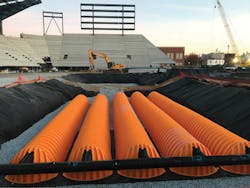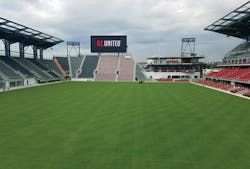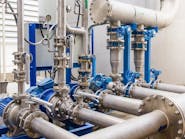Two Systems Control Runoff at New D.C. United Audi Soccer Stadium
Two underground systems add to the high quality of the new Audi Field at Buzzard Point, the new home for D.C. United of Major League Soccer. Opened in July 2018, the stadium, which cost approximately $500 million, will also host other sporting and cultural events, community activities, and concerts. The state-of-the-art urban facility has a capacity of 20,000 with 31 luxury suites, a bike valet, and 500,000 total square feet of mixed-use retail and residential space on the 110-acre site. This also includes the stormwater drainage storage system and a pipe network under the pitch to help dry and cool the natural grass. In addition to designing and building a premier sports stadium, the project is striving to reach a Leadership in Energy and Environmental Design (LEED) Gold certification.
“The preliminary design called for four large ‘box of rocks’ infiltration areas under the field,” explained Branch Echols, project manager for Joseph J. Magnolia Construction Inc. (Washington, D.C.). “They were nine feet deep to the bottom and each one would have required quite a bit of layback excavation to meet OSHA requirements, not to mention quite a bit of stone backfill.” According to Echols, the D.C. Department of Energy & Environment (DOEE), which oversees stormwater management, restricted the amount of stormwater runoff that it would allow to outfall into the public stormwater network. “Underground stormwater retention was necessary because space was not available for construction of typical BMP retention ponds,” he said.
The goal was to detain and store stormwater runoff in order to control flows at the same level as before the new construction. But due to the limited area of the site, there were restrictions on the amount and size of materials that could be used, and the schedule was tight as well. Calculations showed that a system capable of handling more than 50,000 gallons of water would be required. As this was a design/build project, Magnolia was able to propose an alternative that greatly reduced the amount of excavation required as well as the amount of stone backfill.
The stormwater storage system used 242 StormTech MC-3500 chambers to handle the design capacity specification of 50,000 gallons of water.
Additional access restrictions were created due to the aggressive schedule and specific construction milestones along with facilitating deliveries and staging of the stadium’s structural steel. In order to work around these obstacles and comply with the required storage capacity requirements, Magnolia proposed using StormTech® chambers instead of large, stone-filled infiltration areas. StormTech chambers, a product of Advanced Drainage Systems Inc. (ADS) based in Hilliard, Ohio, are designed in accordance with AASHTO, ASTM and CSA design standards, qualifying them for use in commercial and municipal projects. Made from an engineered grade of impact-modified polypropylene copolymer, the chambers are made to provide a 75-year service life.
A total of 242 StormTech MC-3500 chambers were used to construct the eight systems at the site, providing a total installed volume of 51,142 gallons. Each chamber, without end caps, measures 90 inches long x 77 inches wide x 45 inches high and has an installed volume of 178.7 cubic feet of water. Ferguson Waterworks (Newport News, Va.) supplied the chambers from its Upper Marlboro, Md., branch and coordinated the just-in-time deliveries to the downtown site.
There are five chamber units under the field and three others under bioretention fields outside of the stadium, which are dedicated to store runoff from the roof, sidewalks and parking lots.
“There was no place for a laydown area to construct storage units or stockpile stone,” Echols said. “Every square foot of the site was being occupied by either men, equipment or both.” With the chambers, the project was able to meet DOEE’s stormwater retention requirements as well as reduce the required laydown area to only a couple of pallets.
Work inside the stadium had to be coordinated around the structural steel subcontractor due to their mobile cranes and large staging areas needed for the structural beams. “Because of this, we were restricted to windows of time to complete the installation, so it was imperative to have all of our material on site and ready,” said Echols. “The chambers were delivered well ahead of time, taking up a very small footprint, and we were able to install each system quickly and efficiently, with minimal disruption to the work going on around us.”
Space was tight during construction of the new $500 million D.C. United Audi Stadium.
Due to the staging of large steel beams adjacent to the excavation, the team only had access from three of four sides. “To overcome this, our general superintendent came up with the idea to use a crane and large concrete bucket/hopper when placing stone between and around the chambers.” They staged a mini-excavator next to the stone stockpile and alternated filling two concrete hoppers, enabling the crane to keep moving with no downtime for loading. “Normally, we would have used a large excavator to place the #57 stone, which also would have taken longer,” said Echols. “The crane cost a little more, but we were able to save time and beat our estimate, which ultimately resulted in a cost savings.”
Along the sides and on top of the chambers, ADS 0601TG non-woven geotextile was used as a soil separation layer. Underneath the chambers, ADS 315WTM woven geotextile was used to add scour protection.
Sub-Surface Pipe System
In addition to the stormwater storage system, a network of high-density polyethylene (HDPE) pipe runs under the pitch. This system uses perforated pipe to provide additional drainage into the chambers and can be used to air-dry and even cool the natural Northbridge Bermuda grass, installed by Precision Turf LLC (Sugar Hill, Ga.) in time for the first D.C. United match in July 2018.
“This is very similar to a lot of the drainage systems we put in on high-profile fields,” explained Kyle Simonian, general superintendent of Precision Turf. “The only difference is the oversight nature of both the lateral lines and the trunk lines that are under the field. We ran two 24-inch HDPE trunk lines, and coming off of each are 6-inch perforated HDPE pipe lines. We used ADS N-12® dual wall pipe for each.” The perforated pipe not only accomplishes simple gravity drainage but can also be hooked up to a blower/vacuum unit at the downstream side of the pipe. “It can actually blow warm or cool air depending on the season, or put the whole system under negative pressure to increase the drainage flow rate of the system.”
The completed field with five stormwater storage units and a network of pipes for drainage and sub-irrigation.
More than 1,000 feet of the 24-inch diameter and 8,860 feet of the 6-inch diameter perforated HDPE pipe was installed by a crew of six in about 15 working days.
The laterals are buried between 24 and 30 inches below the surface, which is engineered soil and gravel. The subgrade is flat on this field, not pitched with a crown down the middle as is sometimes found on a field. The crew used an excavator with a rotating laser to get the ditches pitched for the gravity flow.
“The water flows into a chamber that is a basically a settling tank and when the outflow is above the bottom of the box, that water goes underneath the field below into the StormTech system to capture the water and allow it to slowly infiltrate into the ground.”
The first game at the new stadium attracted a capacity crowd on July 14, 2018. Unfortunately, D.C. United lost to the Vancouver Whitecaps 3-1, but the field was a clear winner. IWW
About the Author: Steve Cooper has reported on a variety of water and pipeline projects over the past several decades. Based in New York, he has traveled extensively to conduct on-site news interviews with professional engineers, contractors and government officials. He can be reached at [email protected].
Circle No. 139 on Reader Service Card




